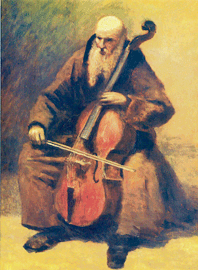|
Nicole Coppey What is art… who is an artist… ? Music, movement, painting, poetry, architecture, sculpture….., all means of artistic expression. But what is art… who is an artist… ? Art, the channel of universal human expression rises from the personal, intense, profound voyage of human experience. It involves the whole being for the reason that it concurrently calls upon the senses, emotions, and the mind. In my opinion the true artist is the person who draws out the art and beauty that dwells in the deepest parts of his inner being which he then communicates through his personal authenticity. One can see an image of the artist’s creation by means of a sound produced by a string and magnified by the sound post and the sound box of the cello. To get started an artist begins his work with a base material: sound, matter, technique, sensorial perception, model, idea, concept, message… . Like the sculptor or the stringed-instrument maker who seeks out the best quality material for his work, art has to come from unswerving intention, it has to rest on best quality support, able to last for generations, (this is just as true for fleeting works in which the memory will remain incorporeal, thus lasting…) You can’t build without good foundations. Perfect materials for a perfect result? However, in art perfection is not the only goal. Art for art’s sake, as lauded by Théophile Gautier, doesn’t have meaning unless is stays embodied, unless it keeps its human dimension, that which renders it perceptible. No matter how important quality in the foundation is, this is not enough to guarantee splendor. Imperfections are the reminder in art of its human dimension, wherein lies its charm. Technique is at the service of artistic expression and conditions it, as does the chosen material which will impose formal logic to the visual arts: “Artistic sense is not a mechanical thing,” says the pianist Tamás Vásáry. “You are not a computer…and if you concentrate too much on precision, you lose the essence of art which is emotion; experience something and communicate it. Especially something connected to love. In other words, how can you feel love if you are a race horse or a computer?” Virtuosity is primarily an important means to express a complete palette of feelings. Liszt went even further: “Music does not express feeling, it is in itself feeling.” A work of art is inspired by infinite love, complete with all its joy, sorrow, feeling, in all the different kinds of nuances that a person can experience. It generates emotion, which is at the heart of life. To take feeling and emotion away from art, is to cut off the vital link that bonds it to human nature. In its own way each type of art seeks these emotions. “As a musician can give his emotional impressions to a sunrise without the sound of a crowing rooster, so the painter has purely pictorial means to render his impressions of a morning without painting the rooster.” (Kandinsky) Art in music As it is with the other arts, music helps the human spirit to perceive universal ideas. Through its rhythmic, melodic, and harmonic components, music excels in this task. Rhythm gives it life (movement, heartbeats), it evokes the tempo and its duration, defines the unity, the divisions and iteration. Melody, less quantifiable, conveys the emotions and speaks to our feelings in an irrational way. And finally harmony sets up a frame of reference (the tonal system), based on universal dimensions, allowing one to convey the colors of each tonality. A musical work is the sum total of a complex combination that unites forms, mouvements, colors, sounds, dreams, poetry, plasticity, the spatial, and the temporal, into one genuine musical design. As a result the artist must undergo a journey in order to discover his core and be able to communicate the emotions that emanate from therein. It is therefore no surprise that artists themselves often become involved in other art forms than their own. Notably for example painters, who developed their sensitivity through a contact with music: Véronèse, Delacroix, Kandinsky. Schumann suggested to an accomplished musician to study one of Raphaël’s Madonnas, and to a painter he suggested he study a symphony by Mozart. Debussy, drawn to pictorial art, proposed “to create a work in a very special color which will give rise to as many sensations as possible”. Art is a mission If, from now on, a musical work is to be considered as a combination of the arts, then why not create more recognizable links to the other arts, with each one through their own means of interaction transmitting an even deeper message? Human beings being multi-tasked, therefore why not provide multiple means of experience in one concert? Since the opening 8 years ago of our school “Un, Deux, Trois Musiques…” in Sion, we have put forward an artistic pedagogy based on music and the person, developing not only musical ability, but also the gifts of artistic expression and creativity. In addition to this, we have created recitals based on educational themes such as: music and painting, …poetry, …literature, …sculpture, …gastronomy, …language, …movement, … All of these themes provide not only an indisputable opening to art in a manner which is global, but they also cause us to endeavor to view art as a whole, generating complementary emotions. You can read the text in French language in the "Revue Musicale Suisse" of December 2005 page 13 |
 “Jean-Baptiste Corot “Monk with
a Cello” Hamburg Kunsthalle”
“Jean-Baptiste Corot “Monk with
a Cello” Hamburg Kunsthalle”
|